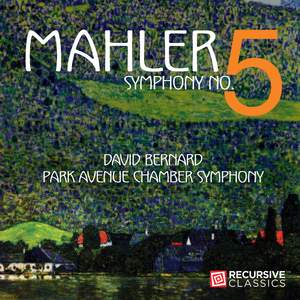
Gustav Mahler (1860-1911)
Symphony No 5 (1901-1902)
Park Avenue Chamber Symphony/David Bernard
rec. 2022, DiMenna Center for Classical Music, New York
RECURSIVE CLASSICS RC5956731-D [71]
I had not yet heard, or even heard of, the Park Avenue Chamber Symphony (PACS). Their website tells us it is “made up of individuals from diverse professional and cultural backgrounds, [and] PACS musicians all share a passion for gathering together weekly during the non-summer months to play, record and perform the classical orchestral repertoire. PACS musicians hold themselves to the highest musical standard and play with a commitment and pride rarely found in ensembles whose members perform without compensation.”
The orchestra won the American Prize Competition in Orchestral Performance in 2011, 2012 and 2013. The judges described their performances as “extremely impressive, well-shaped. This ensemble is good enough to surpass many professional orchestras, performing incredibly difficult repertoire on a professional level.”
That “surpass many” sounded like an overstatement, so my inner Beckmesser was alerted. I took my slate and my score of Mahler Five and began to listen. Yes, there were a few reasons to scratch some adverse comments, even the opening trumpet solo, bold and brash, not the noblest summons to a funeral maybe. But why not? The playing, not only of that instrument, had skill, character and commitment, so I closed the score after two movements and just enjoyed a very good account of what is after still a huge and demanding work to perform. Conductor David Bernard knows his way round the symphony. He is clearly well able to help his capable musicians negotiate its not infrequent tricky corners, and offers very considered and idiomatic Maher conducting throughout.
The first movement has the requisite lachrymose power at the outset. Although there is plenty of fire at the “Suddenly faster…Wild” marking, the speed is not too frenetic. The ensemble is not quite immaculate here, but there is no reason to make any allowances for this playing, which is generally very good. The second movement flows well towards the coda’s chorale, and the trumpets sound a fine apotheosis. The “corno obbligato” part of the third movement scherzo is certainly well played, and the agreeable geniality of the Ländler and waltz sections are nicely characterised. The manner is very Viennese, helped by the conductor’s instinctive and persuasive rubato. The strings are excellent in the Adagietto, with good tone and real feeling for this love song. David Bernard sets a middling tempo, taking just about ten minutes, effectively mediating between the seven minutes of Walter and Mengelberg (who both knew the composer), and the twelve or thirteen minutes of a few overindulgent conductors. In a few moments, such as in the finale at 7:23, the violins can sound undernourished, but these really are passing moments. Indeed, I can cite those first seven minutes of the finale as a good section to illustrate the qualities of the orchestra, its woodwinds in particular.
Here is perhaps the main issue: Mahler wrote “For large orchestra” on the title page. What size of band do we have here? There is no player listing, a shame since several solos deserve recognition. The photo in the booklet shows an ensemble biggish for a chamber orchestra, with a string section founded on four basses, three trombones, three horns (a fourth horn probably cropped out by the page edge), and so on. It does not say what work they have been playing but this “chamber symphony” takes little notice of the diminutive implied by their title, either in numbers or ambition. They have recorded the Rite of Spring! If there is an occasional lack of weight in the biggest tuttis, it is does not much constrain Mahler’s dynamic range.
There is a good stereo image on this recording. An unusually sophisticated booklet note (English only) adapts a musicological article on the symphony by Vera Micznick, and there are insights from the conductor. Direct comparison with any of the innumerable fine recordings by top professional orchestras seems beside the point. Here we have energy in the bustling counterpoint, warmth in the lyrical passages – which are often truly con amore – and that compelling narrative arc through each movement which holds our attention in a big symphony. In summary, these players give a very good account of the work, and indeed of themselves. There is commitment in the playing, and never a sense of routine, or just a “day at the office” (that is not unknown in major orchestras who have played this work once too often). That may be because many of the PACS players have to do real days at the office much of the time.
I cannot quite banish a fantasy about this disc, so by way of envoi let me indulge it here. Imagine that for one of the later rehearsals, when PACS has been working on this piece for many weeks, David Bernard is indisposed. He arranges for his place to be taken by a conductor who has stood before the Philharmonic Orchestras of both Vienna and New York, and who knows the work better than anyone, because he wrote it. Gustav Mahler is known to be a rather tyrannical maestro, but he was in NYC anyway when David called and told him about this organisation presuming to play his music. If this disc represents what our remarkable revenant heard, what would he say after his first run through with the players? “Ladies and gentlemen, my last orchestra was a distinguished Imperial institution, not a community-based group of volunteers. So we still have some work to do. But that was very good – thank you for learning my Fifth Symphony, and playing it so well.” With that, he vanishes.
Roy Westbrook
Help us financially by purchasing from




















